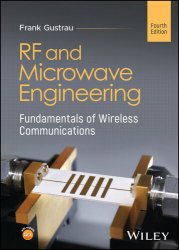 Название: RF and Microwave Engineering: Fundamentals of Wireless Communications, 4th Edition
Название: RF and Microwave Engineering: Fundamentals of Wireless Communications, 4th EditionАвтор: Frank Gustrau
Издательство: Wiley
Год: 2025
Страниц: 355
Язык: английский
Формат: pdf (true), epub (true)
Размер: 59.7 MB
A comprehensive guide to the fundamentals of radio frequency (RF), microwave engineering, and the physical aspects of wireless communications.
Combining physical-technical fundamentals with numerical simulations, RF and Microwave Engineering presents a wide range of RF topics with emphasis on physical aspects such as electromagnetic (EM) and voltage waves, transmission lines, passive circuits, and antennas. The text discusses the propagation of waves and their representation, effects, and utilization in passive circuits and antenna structures, incorporates various design examples using circuit and EM simulation software, and gives examples of modern RF tools to show how methods can be applied productively in RF engineering practice.
This revised edition includes new chapters on monostatic and bistatic radar cross sections (RCS), horn antennas, 5G mobile communications, substrate-integrated-waveguides (SIW), slot antennas, characteristics of resonators, and other topics.
A list of practice problems is provided at the end of each chapter and a companion website hosts solutions to the problem sets.
At low frequencies, the electrical behavior of real concentrated electrical components like resistors, capacitors and inductors is approximated by idealized nominal values. With increasing frequency parasitic effects become more pronounced and have to be considered for realistic circuit design. Parasitic effects result from losses in conductors and dielectric or magnetic material, inductances of wire leads and capacitances of contact terminals. We will derive simple and physically reasonable equivalent circuits of the most important concentrated elements: resistor, capacitor and inductor. Each of these equivalent circuits consists of three ideal elements and is quite useful and sufficiently accurate for many practical applications.
We can further improve the accuracy, extend the frequency range and expand the scope of applications by considering more complex equivalent circuits including more than three elements. However, it is more difficult to determine these elements of the complex equivalent circuits, for example from measurements. Furthermore, with increasing frequency the physical mounting condition effects the component behavior. Coupling effects between the electrical component and the circuit environment have to be considered. Resistors come in different shapes and package types. High-frequency circuits commonly use
surface mounted device (SMD) components. These components are rectangular in shape and exhibit low parasitics due to their small size (typical length ∼mm) and direct mounting (no wire leads) onto the surface of the printed circuit board (PCB). By using two concentrated elements (capacitor C and inductor L) we can design parallel and series resonance circuits. At higher frequencies, it is more difficult to use concentrated elements due to the parasitic effects discussed in the previous section. In RF engineering transmission lines become an interesting alternative.
Written by a highly qualified professor this is the English language translation of the German original. RF and Microwave Engineering includes:
Transmission line theory and transient signals on lines, covering characteristic line impedances, voltage waves, idealized lossless lines and cables with low losses, impedance transformation, reflection coefficient, and Smith chart diagram
Waveguides, covering coaxial lines, including weak losses, parallel wire lines, microstrip lines, rectangular waveguides, substrate-integrated-waveguides, and three-wire systems
Scattering parameters, covering multiport equations in matrix form, special network properties of circuits, and the signal flow method
High-frequency components and circuits, covering line filters, couplers, power dividers, and matching circuits
Antenna concepts and radio wave propagation in complex environments
RF and Microwave Engineering is an essential text for undergraduate and graduate students in electrical engineering courses including microwave engineering, basic circuit theory, electromagnetic fields, and wireless communications as well as early-stage RF practitioners and engineers.
Contents:
Скачать RF and Microwave Engineering: Fundamentals of Wireless Communications, 4th Edition
